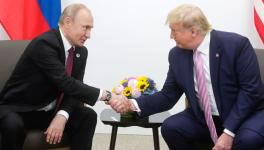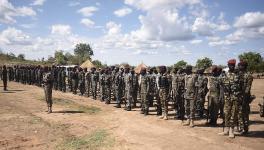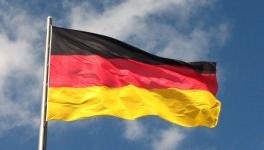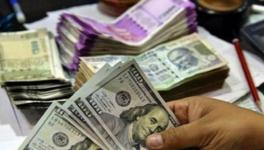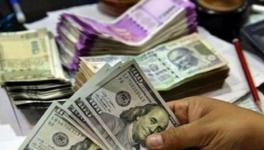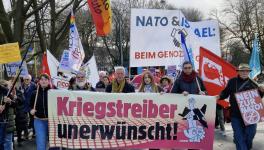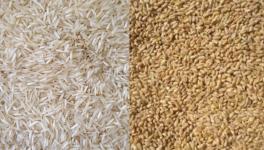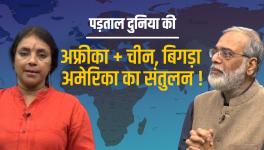Global Implications of Covid-19 and the Economic War on Russia
Three interrelated shocks have impacted the uneven recovery of the world economy from the “Great Recession” that began in 2007. These are the ongoing efforts of the United States to try and retain its hegemonic status, the Covid-19 pandemic, and the conflict in Ukraine. All three have implications for international political economy.
Covid-19 was clinically detected in January 2020, but most developed countries disregarded lessons from China’s public health practices to deal with the pandemic. As a result, they suffered avoidable economic and public health ruin. They did not utilise their relatively high per capita incomes and public health infrastructure, which could have minimised this ruin, since it was incompatible with the hegemony of the neo-liberal project in them. Instead, their elites scapegoated China and misattributed the failures of neo-liberal policy to tackle the pandemic to the “idiosyncrasy” of some leaders, such as Donald Trump.
Most developing countries entangled in the neo-liberal project could not afford to deal with Covid-19 effectively. The absence of capital controls meant that their governments could not expand their fiscal deficits as per the public health requirements and the needs of workers, peasants and small firms. Instead, their fiscal deficits had to be maintained at (lower) levels that international finance found “acceptable”.
In many developing countries, such as India, it is arguable that even the limited “fiscal space” remained inadequately utilised. As a result, there were extensive setbacks to India’s economic activity and public health. The latter is exemplified by India having among the highest excess deaths due to the pandemic.
Until vaccines were available, non-pharmaceutical interventions such as lockdowns, masking, hand sanitisers, travel restrictions etc., had to be instituted. This prevented some deaths from Covid-19, but measures such as lockdowns that most countries took resulted in a global recession. This is because most governments operating within the ambit of the neo-liberal project were unable to tax corporates to promote a globally-coordinated fiscal policy. However, uncoordinated fiscal stimuli, relatively more expansive in the developed countries, did prevent the recession from worsening into a full-fledged depression.
The short term adverse economic impact of Covid-19 affected employment and wages more than output, though all three economic variables declined during this phase. In other words, policies in most (but not all) countries resulted in the corporate sector gaining at the expense of workers, peasants and small firms. This adverse change in income distribution negatively affected demand, output and, eventually, investment. That explains why the world economy did not rapidly “bounce back” to pre-pandemic levels whenever there was a dip in Covid-19 infections and deaths.
After vaccines were available, two policy strategies to deal with Covid-19 emerged: “living with Covid” and China’s zero-Covid strategy. The first fallaciously counter-poses vaccination to masking and other non-pharmaceutical interventions. First, vaccination does not prevent an infected person from infecting others. It reduces the likelihood of severe disease and death among the vaccinated. Second, many countries de-emphasised masking and other non-pharmaceutical interventions even before vaccination had become universal. As a result, in countries “living with Covid”, there were repeated waves of Covid-19 involving cyclical movements in economic activity and infections and deaths.
Vaccine hesitancy, due to the incompatibility of scientific temper and the hegemony of the neo-liberal project, exacerbated these waves, as did the transitory efficacy of a vaccine dose, mutations and recombinations of the virus (due to greater transmission) and the premature withdrawal or attenuation of the (limited) government support to workers, peasants and small firms. Further, Long Covid has attenuated public health achievements in countries “living with Covid”.
The dynamic zero-Covid strategy, in contrast, achieved a rapid convergence to disease elimination. It resulted in higher cumulative economic activity and lower aggregate infections and deaths due to Covid-19. However, the hegemony of the neo-liberal project had the inferior “living with Covid” strategy become the norm in most countries, with devastating economic and public health consequences.
As the Covid-19 pandemic gripped the world, some mainstream media and related policy circles claimed global value chains (especially in East Asia) would shift away from nations such as China. A section of American elites was concerned about their “dependence” on China, which became apparent during the pandemic. Such claims are based on a misunderstanding of the factors that underlie the geography of global value chains. These factors derive primarily from profit-based decisions of firms and include production costs, access to demand sources and proximity to other segments in global value chains.
Indeed, the divergent approaches to dealing with Covid-19 between China and the developed countries might have widened the gap between the two locations regarding demand and costs. On balance, currently, there is no viable alternative to the centring of global values in East Asia. Claims to the contrary are largely “aspirational”.
The economic war against Russia, led by United States elites, will have significant consequences for the world economy. First, a part of the foreign exchange reserves of the Bank of Russia (central bank of the Russian Federation) were “frozen”. These reserves were held as government securities of “allies” of the United States, or the USA itself. So, the freezing tantamounts to default on interest and principal on these securities. In other words, it is a gratuitous appropriation. Second, several Russian banks have been disconnected from the SWIFT system. Third, many (though not all) multinational corporations have pulled out or plan to pull out of Russia. Fourth, the trades in many commodities between Russia and the United States or its “allies” were proscribed.
Fifth, the assets of Russian elites and government located in the territory of the USA and its “allies” have been, by and large, confiscated. America’s elites believe such a “maximum pressure” strategy will have the Russian government agree to a settlement in the conflict in Ukraine that the USA finds acceptable. This belief has not been validated till now, partly because of the Russian government’s numerous countermeasures to the economic war.
First, the Bank of Russia imposed capital controls, effectively disallowing even current account convertibility of the rouble. Second, it initially increased the policy rate to 20% to try and retain finance capital. Third, it offered to buy gold at a fixed price in terms of roubles, i.e. 5,000 roubles per gram. Fourth, the European “allies” of the USA have no viable alternative to Russia for supplies of several commodities such as gas, oil, uranium and titanium. Therefore, “creatively tweaking” their economic aggression, they have continued direct or indirect trade with Russia in such commodities. For instance, a “sanctions compatible” Latvian oil blend has been devised which involves mixing Russian with oil from other sources. Likewise, the Japanese government has said that to preserve its energy independence, it will not exit joint natural gas projects in Russia.
Fifth: the Russian government has traded with “friendly” countries in national currencies, bypassing the US dollar. Regarding “unfriendly” countries (America and its “allies”), the Russian government has demanded they pay for imports in rouble terms. Sixth, the Russian government has allowed imports of “unbranded” items to replace the proscribed imports from unfriendly countries. Seventh is the domestic takeover of the assets of multinational corporations of unfriendly countries in Russia that want out. Eighth, since the United States government is unwilling to allow Russian government debt service payments to non-Russian entities in US dollars, the Russian government has offered to pay these creditors in roubles, which is technically being interpreted as a default. However, given the scale of the economic war and the countermeasures, the likely adverse consequences to Russia of such “default” may not be strong enough to change Russian policies to ones the United States elites would consider favourable.
Consequently, Russia fully reversed the initial fall in the rouble-USD exchange. The Bank of Russia has, therefore, reduced the policy rate of interest to 17%. Likewise, the offer to buy gold at a fixed price in roubles has been modified to purchase at a “negotiated” price. Neo-liberal economists argue this is a “rigged” exchange rate and that once Russia withdraws these policy measures, the rouble will again plummet vis-a-vis the dollar. Needless to say, “non-rigged” exchange rates are those determined by the caprices of international finance. Neo-liberal economists also lament that the Bank of Russia is no longer “independent”, since it is not actively advancing the interests of international finance and, therefore, United States elites.
However, the Russian government has only partially broken with the neo-liberal project under exigencies. In Russia, inflation is at 20%, but the government seems unwilling to institute adequate price controls or deal with speculative stock holdings that push up domestic inflation. It also appears reluctant to provide guaranteed employment or expand public investment, which could stabilise those domestic output sectors which are demand constrained. Of course, it could overcome domestic output sectors constrained by inadequate availability of inputs from unfriendly countries with import substitution from friendly countries. But it is unclear if the Russian government will adopt such a far-reaching industrial policy.
Even before this economic war, inflation spiked in many countries—not because a fiscal stimulus during the pandemic raised wages, launched a wage-price spiral, and corporates responded with price increases. The share in the output of wages, peasants and small firms has, in fact, fallen. Instead, policies ostensibly dealing with the pandemic involved central banks in developed countries offering a virtually unlimited supply of finance, directly or indirectly, to the corporate-financial oligarchy. These funds went into activities where the corporate financial oligarchy expected the highest return.
The dislocation of global value chains due to the “living with Covid” strategy created some shortages of (principally) primary commodities. The corporate-financial oligarchy, as expected, speculated in these commodities, and this was the principal driver of inflation. An additional factor was the selective squeeze on small firms. The skewed response to the pandemic increased corporate monopoly power over determining prices. The dislocations and shortages of the economic war have further raised expectations of price hikes in primary commodities resulting in a fresh bout of speculation. Hikes in the policy rate of interest to try and restrain inflation are expected to work by reducing demand, output, employment and, consequently, wages. But this will also reduce investment.
If the investment decline weakens the supply response more than the decline in demand, then inflation will not taper off. For instance, if rising interest rates slow investment in alternatives to Russian energy for European “allies” of the USA, speculation-driven commodity stock-holdings will keep inflation high for a more extended period. Further, if the United States perceives the Ukraine conflict as taking a direction it finds unacceptable, it may intensify the economic war which will exacerbate the inflationary upsurge.
Since Russia is a significant exporter of fertilisers, and along with Ukraine, a substantial exporter of agricultural produce, the economic war will result in financial distress and food insecurity, especially in developing countries. Even the United States government has kept Russian fertiliser exports outside the ambit of its economic war. However, increased agricultural trade between developing countries will only redistribute food insecurity unless world agricultural output rises. If governments seek to enhance their contingency food stocks, it will aggravate global food insecurity.
The economic war will likely exacerbate the divergence in production costs, demand, etc., between China and developed countries. The United States has largely persuaded Germany and Japan to join its economic war. As a result, they are likely to have reduced access to Russian inputs such as energy and minerals in the short run. They may find more expensive alternatives to some inputs in the long run. So, the production cost divergence between China and Germany and Japan could widen.
Further, since most countries (including China and India) seek normal economic ties with Russia, involving both defence products and other commodities (principally inputs). Therefore, they are likely to obtain these inputs and at discounted prices from Russia. Many European and some Asian “allies” of the United States have been persuaded into delinking from Russia, compelling it to find alternative buyers for its commodities through discounted sales. The outcome will be to increase the production cost divergence between China and, Germany and Japan.
If Germany and Japan seek to control production costs by squeezing wages, the demand divergence between China and them will heighten. Further, if China moves up the technological ladder through a process driven by public investment, then more fundamental shifts in the existing geography of economic activity may be imminent.
In this light, it is possible to discern why the efforts by the United States to isolate Russia have come a cropper. Russia is an inalienable supplier of defence products, energy, minerals, and other primary commodities. With no viable alternative source, the threat of secondary sanctions on countries that refuse to cut off economic relations with Russia has been underwhelming. Therefore, it has tried to ratchet up tensions over Taiwan which may heighten conflict. The United States, it seems, is unable to come to terms that the “unipolar moment” has indeed ended; the ability of the US dollar to function as a reserve currency has again come into question.
Several factors made the US dollar the global reserve currency after the dollar-based gold standard ended. First, more often than not, the United States government has ensured the dollar price of critical commodities such as oil is bounded in both directions. If the dollar price of oil is high, then relatively high-cost shale oil in the USA will be supplied, which will keep oil prices in terms of the US dollar bounded from above. Additionally, Saudi Arabia, by trading oil for security (United States military support), has acted as a swing producer. In other words, the United States government can persuade the Saudi government to alter its oil supply to keep the dollar price from rising or falling. Second, the trade in essential commodities such as oil is predominantly dollar-denominated. Third, the proceeds of oil sales by many countries in West Asia are deposited in United States banks or held as United States government securities.
Fourthly, the United States economy was deeply enmeshed in global value chains till recently as a source of invention, a site for the design of advanced technology-based commodities and a significant market for many items. This third role was financed by governments with an export surplus vis-a-vis the United States lending to its government.
However, to varying degrees, the United States has declined in all three roles in global value chains due to China’s rise and the latter’s significant trade and investment integration with most economies. The United States is no longer central to world trade in commodities but is still a centre of international finance. Gratuitous appropriation of a part of the reserves of the Bank of Russia is a warning to those countries that are not its “allies”. These countries will seek to diversify their central bank reserves towards currencies other than the US dollar (and undertake international trade in other currencies). If China emerges as an alternative to the United States in invention and design, it will further marginalise the US dollar in global economic activity. However, unless major economies impose capital controls on international finance, the emergence of an alternative to the US dollar as a reserve currency is unlikely.
If Covid-19 resurges and developed countries persist with “living with Covid”, the shift of global value chains towards East Asia and the attenuation of America’s hegemonic status may accelerate. Its extent will depend on the strategic breach between China and Russia remaining below a threshold. The outcome of the conflict in Ukraine will also have a decisive role. Through a combination of economic, political and military means, the United States will contest its loss of hegemonic status. For a democratic outcome to this contest to emerge, developing countries will have to cooperate closely, combat the economic and public health consequences of the Covid-19 pandemic and tackle the fallout of the economic war on Russia together.
The author is professor, Department of Economics, Satyawati College, University of Delhi, India. The views are personal.
Get the latest reports & analysis with people's perspective on Protests, movements & deep analytical videos, discussions of the current affairs in your Telegram app. Subscribe to NewsClick's Telegram channel & get Real-Time updates on stories, as they get published on our website.











